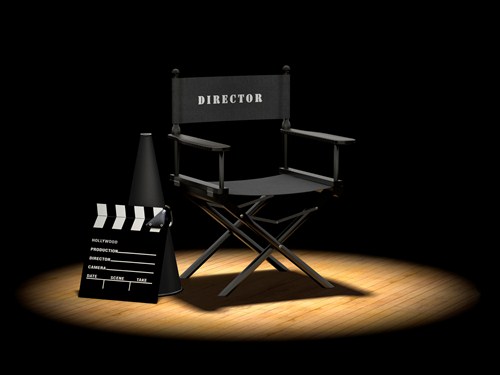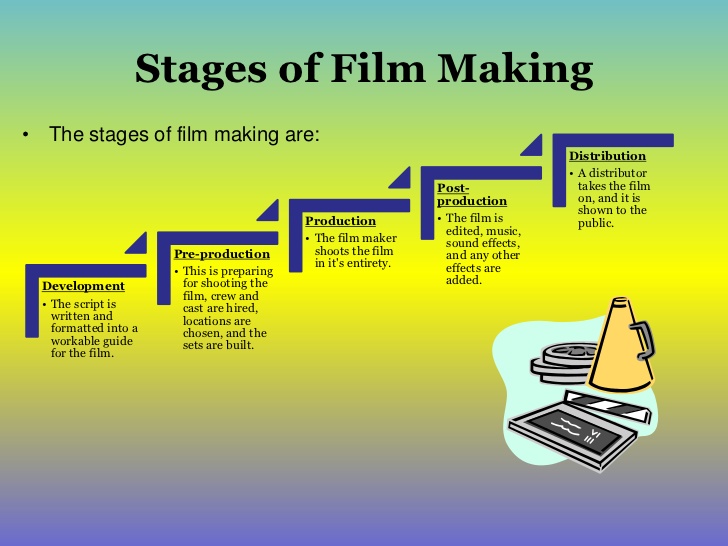D STUDIO FILM INSTITUTE
Acting,Direction,Cinematography -
Chennai


The filmmaking process is commonly divided into five phases: Idea and Development; Pre-production; Production; Post-production; and Distribution. Working according to these phases can help you do the job in a logical order, with as little complications as possible, since each stage of the process is based on the successful completion of its predecessor.
Phase 1: Idea and Development
Finding the
initial idea for the film is the core of the whole filmmaking
process. Inspiration is often elusive, not only to filmmakers but
to other artists as well, and you might want to ask yourself a few
questions in order to find what it is that you want to say to the
world: What topics are close to your heart? On what topics do you
feel you have a unique voice or a unique perspective? What new
ideas do you want your audience to think about? What experiences
and notions do you want to share with them?
Not every
idea for a film is a good idea for a film, and indeed, most
concepts won’t make it to the next level. But once you find an idea
that excites you, you will need to develop it so it forms the
foundation of your film. This phase of the process will help you
understand exactly what you want to say and how you want to say it,
and will make it easier for you to convey it to other people,
on-set and off-set, thus making sure that everybody’s on the same
page.
Working on
paper can help you put things in order. Think about the structure
of your film: it should have a beginning, middle and end. Think
about your target audience, who they are and what you want them to
feel after watching your film. In order to make sure you know
exactly what your film is going to be about, try to describe the
whole story in just one sentence, then in just one appealing
paragraph – this will also help you when you search for
funding.
Next, write
your script using a script format; think about characters,
dialogues, sights and sounds. An important tip is to have all
details in the script, but not too many details: a good filmmaker
should always know his strengths and weaknesses, and allow the
professionals who work with him to make decisions in areas he’s not
familiar with. You can also make a graphic storyboard.
You will
often discover you need to do some research in this phase. If your
film refers to times or places you don’t know personally, research
all relevant historical and cultural aspects in order to make your
film as reliable as possible. Spend time designing round
characters, their lives and their motives.
Phase 2:
Pre-Production
Many
consider the pre-production phase the most important phase in the
filmmaking process. In pre-production you plan all the logistical
and creative aspects of the production, while trying to think about
all possible problems and tackle them in advance. For that reason,
a good, comprehensive pre-production can save you a lot of time,
money and effort.
Casting
takes place in the pre-production phase, and as the face of your
film, the actors you choose are crucial for its success. Schedule
auditions, cast actors for all parts and conduct rehearsals. Actors
should also have the time to make researches of their own, get to
know their characters and understand them.
Planning
your schedule is a major part of pre-production. Try to estimate
how many days of production you’re going to need in order to get
all the wanted audio and visual materials, and plan your days in
the most cost-effective way possible. Budget should also be taken
under account when planning the production itself and it’s
important to keep track on expenses at all times.
Other topics
that need to be settled in the pre-production phase are finding
locations, designing and constructing sets, planning basic camera
movement and coming up with Plan Bs in case things don’t go as
planned (e.g. weather problems).
Phase 3:
Production
The
production is the execution phase of the filmmaking process, during
which all the audio and visual materials are being gathered. On
this phase shooting and recording take place. A large part of the
filming crew participates in this stage, making sure that the
script is being followed accurately and that the materials are of
the best possible quality.
The camera
makes its first appearance during production, and it is important
to know exactly what to shoot and how. Shooting must be based on
the script and storyboard in order to ensure that the right
materials are being recorded; the previous phases should eliminate
any need for improvisation. When recording it is also important to
keep lighting – both natural and artificial – in mind, as it will
help you convey the film’s atmosphere to the audience.
The audio
recording of the film must take place on a silent set, since every
unwanted noise may be recorded on the sensitive microphones. When
starting to record, everyone on set should know they need to be
silent. The cast should also know to speak up and speak clearly so
that their words are easy to follow.
Phase 4:
Post-Production
The
post-production phase includes editing all the materials that were
gathered during shooting, thus assembling it into a fluent,
consistent film. This is also time to insert the overlay of
adjustments and effects that creates the full cinematic experience
you have envisioned. Post-production usually takes longer than the
production itself!
Needless to
say, the raw material of a film is not ready for distribution.
Editing is the process of going through the footage, cutting and
re-arranging it, discarding what is not needed and making sure that
what remains tells the story clearly. To do so, choose the best
takes and use the script and notes you took during the
shooting.
In addition,
during the post-production phase special visual and sound effects
are added and the film’s soundtrack is edited. Color corrections
are made and sometimes a narration is added. This is the time to
title the film. Although all those things may seem as “final
touches”, they have a great influence on the film’s atmosphere and
message.
Phase 5:
Distribution
Distribution
is the process in which the film reaches the audience, and is
therefore the final peak of the whole filmmaking process. It is
done through film distributors, either by a theatrical distribution
or for home viewing, such as DVD releases. Nowadays, a film can
also be shared on the internet. Advertising is, of course, a part
of this phase; use your marketing material in order to stand out in
the busy world of media.



